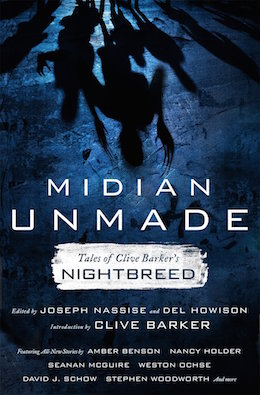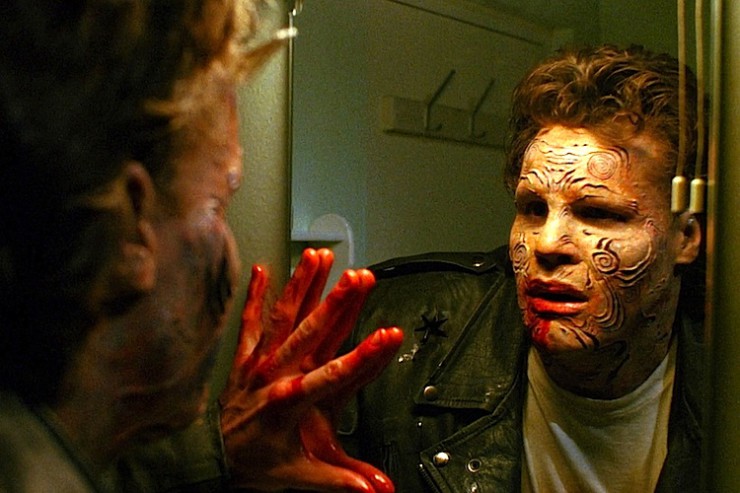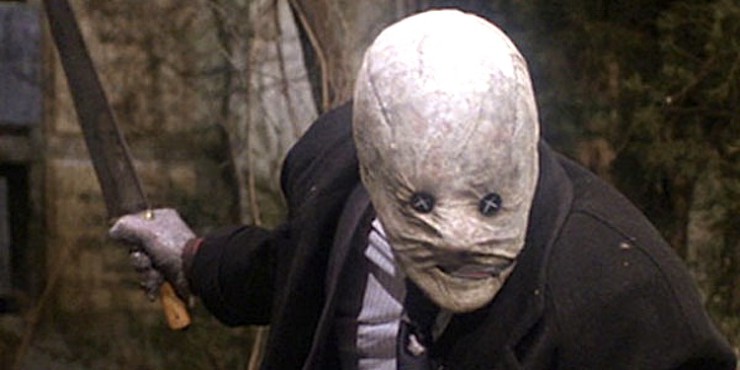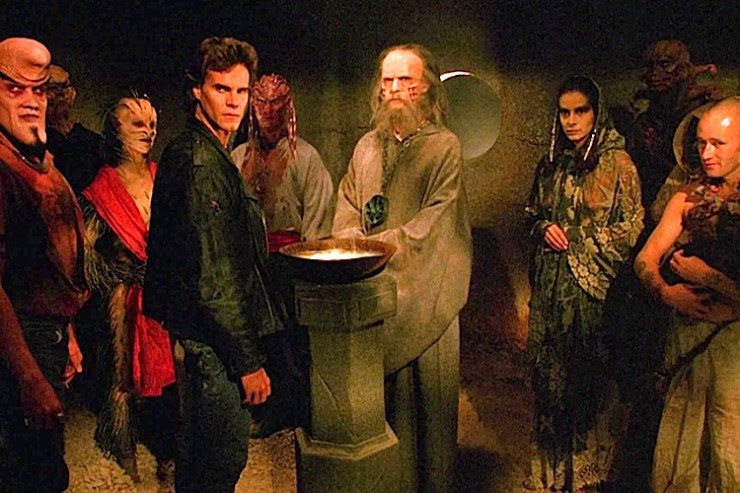Clive Barker has had a bumpy film career. After writing scripts for Underworld and Rawhead Rex, and being underwhelmed with the results, he decided to try directing his stories himself. So he adapted his story “The Hellbound Heart,” and created the classic Hellraiser. Unfortunately, for the next movie he wanted to do a thoughtful, dark fantasy adaptation of his story “Cabal,” but his producers just really wanted a slasher movie.
In 1987’s Hellraiser, Clive Barker’s first film as a director, you can already see the writer-turned director pushing against the constraints of the horror genre. The first half of the film is textbook 1980s horror film: an evil bastard named Frank meddles in dark powers, dies at the hands of creatures called Cenobites, and then comes back from the dead even more evil than before. He coerces his brother’s wife, who also happens to be his ex, into snaring humans to feed his bloodlust. This would normally end with one of the victims fighting back, or with a confrontation between Frank and the demons he’s escaped. But then it shifts. Frank’s niece figures out more-or-less what’s going on, steals the demonic puzzle box that got Frank into this mess in the first place, and learns how to use it. Even though she’s only a side character at the beginning, the movie quickly becomes her story. She meets the Cenobites herself, and makes a deal to deliver Frank back to them. The Cenobites themselves are not evil (I mean they’re not exactly nice…but they’re also not evil) they’re “Explorers… in the further regions of experience. Demons to some, angels to others.” Basically they run an intergalactic BDSM cult, and they make me wonder what kinds of clubs Clive Barker was frequenting back in ‘80s London.
A few years later Clive Barker worked out a deal with Morgan Creek to adapt his story “Cabal.” This time he wanted to get away from traditional horror entirely. He wanted to create a dark fantasy, something more like an adult version of Labyrinth than anything else. But Morgan Creek, which was busy with Young Guns II and The Exorcist III, wasn’t all that enamored with a dense, poetic film that subverted every horror trope it could find, and Barker ran into a problem all-too-familiar to unique filmmakers at that time: his story was too weird to sell.
Clive Barker’s intent to make a different type of movie is clear when you look at his collaborators. He brought David Cronenberg in as an actor, having him play a character who seems more like timeless force of evil than typical serial killer. He brought Ralph McQuarrie in to create gorgeous matte painting of the Nightbreed’s city, Midian, creating a grand world that bled seamlessly into our own. And he had Danny Elfman give the film a soundtrack that featured a choir of children and tribal drumbeats rather than more typical horror music like cheap-scare violins. The heroes Barker had created were a little different. Aaron Boone was more a sensitive dreamer than he-man horror-movie-protagonist, and his girlfriend, Lori, was a singer who had…wait for it…agency. Plus the Nightbreed themselves were beautiful, complex creatures with their own rich history and religion.
It quickly became clear that the studio didn’t know what to do with Barker’s film, however. In an interview with Cinefantastique, the director related a troubling story: “Someone at Morgan Creek said to me, ‘You know, Clive, if you’re not careful some people are going to like the monsters.’” And a few months later, in an interview with Fear magazine, he elaborated:
The head of marketing at Morgan Creek never even saw the movie all the way through, and he was the guy publicising the movie! He could never make it through the film; it disgusted and distressed him. He said to me at one point, ‘You’re an intelligent man, why do you make these movies? They’re disgusting and horrible.’ And this guy was selling the movie!
After a series of preview screenings, the studio began demanding cuts. First they asked for almost an hour to be cut from the two-and-a-half-hour long film, which prompted the editor, Richard Marden, to leave the project. Eventually the movie was cut down to 102 minutes for release, which obviously meant that audiences were getting a very different film than the one Barker shot. A sub-plot that featured Decker having seemingly-two-sided conversations with his mask was cut.
Lori’s role was pared down significantly, as was the film’s ending, which was chopped down until one character who was supposed to die, didn’t, and one character, who is supposed to live (sort-of) isn’t actually shown dying in the first place. The worst change was to the film’s tone. By cutting down the time spent with the Nightbreed themselves, and trimming the humans’ assault on Midian, the studio shifted the ultimate meaning of the film. We lost much of the sense of the Nightbreed as an ancient race of Others who had faced centuries of persecution time and again, simply for being different. The film wasn’t screened for critics, and died a quick box office death, but the hoped-for cult audience did begin forming after the movie came out on video, because plenty of the film’s intended audience understood what Barker was trying to make for them.
 Finally, in 2009, Barker’s film production partner used a VHS copy of Barker’s 145-minute version of the film’s mid-1989 workprint to re-create the original 159 minute version, which was premiered in 2010 at Indianapolis’ HorrorHound Weekend to a rapturous response. The cut restored the hour of footage that had been removed at the studio’s insistence, and it kicked off another groundswell of interest in a director’s cut of the film. Morgan Creek hadn’t thought that there was enough popular interest to justify it, but as the new cut popped up in film fests, it became clear that the movie had a sizeable cult following. The world of Midian itself is ripe for further exploration and expansion, and Tor Books itself just put out an anthology that lets current urban fantasy and horror writers loose inside of Clive Barker’s world.
Finally, in 2009, Barker’s film production partner used a VHS copy of Barker’s 145-minute version of the film’s mid-1989 workprint to re-create the original 159 minute version, which was premiered in 2010 at Indianapolis’ HorrorHound Weekend to a rapturous response. The cut restored the hour of footage that had been removed at the studio’s insistence, and it kicked off another groundswell of interest in a director’s cut of the film. Morgan Creek hadn’t thought that there was enough popular interest to justify it, but as the new cut popped up in film fests, it became clear that the movie had a sizeable cult following. The world of Midian itself is ripe for further exploration and expansion, and Tor Books itself just put out an anthology that lets current urban fantasy and horror writers loose inside of Clive Barker’s world.
In 2012, Russell Cherrington, a film professor and fan of the movie, created a 155-minute-long “Cabal Cut”, which was shown at North Carolina’s Mad Monster Party. During that weekend Anne Bobby, the actor who plays Lori in the film, encouraged everyone to join the Occupy Midian movement to demand a new edit of the film. This time the fan movement worked, as Shout! Factory agreed to release a restored director’s cut. This is not exactly the “Cabal Cut”—it’s a bit shorter, but it has Barker’s preferred ending, and emphasizes the fantastical story and sympathetic monsters over gore.
Even watching the trailers shows the stark contrast in intent. The original trailer screams late-90s horror movie:
While it does at least make it clear the the Nightbreed are the good guys, it also focuses on a slasher subplot that literally takes up five minutes of screen time, and implies that Boone is the hero of the film.
Compare that to the trailer for the “Cabal Cut”:
The trailer is far more atmospheric, makes it clear that Nightbreed isn’t truly a horror film, and puts the focus on Lori rather than Boone.
The film follows its own pattern, and subverts a typical horror film in interesting ways. What begins as a story of a young man finding an alternative family weaves in the story of a young woman’s quest to find him. It acts as a critique of the slasher subgenre, and most pointedly (too pointedly) it ends up being an attack on normal society. The true villains of the film are a disturbed psychologist, a corrupt cop, and hypocritical priest.
As in Hellraiser, the film shifts part of the way through. Lori starts the movie as a classic 80s-horror side character, the hero’s girlfriend who’s there to offer support and encouragement. But after Boone apparently dies, Lori goes on her own quest to learn the truth about the Nightbreed, fights her own battles in her own way, and eventually becomes more of a co-hero than a mere sidekick. It’s Boone who’s coded as a passive, easily-manipulated teenager—allowing himself to be utterly passive to an older, authoritative man, and hinging his entire sense of self-worth on whether the Nightbreed think he’s cool enough to join them.
The movie shows two of the Nightbreed being mistreated by law and health officials in a way that brings up uncomfortable racial and class distinctions in our own society. A woman who enjoys both sex and alcohol receives the usual slasher movie treatment, but with the twist that the audience spends time with her before her murder, and actually feels something for her when she’s killed. Finally, the queer subtext has been remarked on by many people, including filmmaker Alejandro Jodorowsky, who referred to it as “the first truly gay horror fantasy epic.” Most tellingly, the oppressors in the film are a troublesome triumvirate: a psychiatrist who tells a troubled-yet-decent man that he’s psychotic, a cop who is more concerned with press conferences and scapegoating than protecting the public, and a priest who only makes occasional, half-hearted attempts at love and empathy.
Revisiting Nightbreed reminded me of another film from 1990 that became an outsider touchstone: Edward Scissorhands. The usual critical line on Tim Burton is that he emphasizes style over substance, and can’t tell a coherent story. A different way to read his work is that he infuses his movies with a style that is telling the story. You don’t really need much of a plot for Edward Scissorhands. The right kind of person sees a single shot of Edward, spindly and pale and bedecked in bondage gear, standing in front of a line of pastel suburban homes in Central Florida, and they know the story already. (Some of us don’t need to see the movie, Dottie. We lived it.) The point of a movie like that—or any work of art like that—isn’t to get you from Plot Point A to Plot Point B, it’s to make you feel less alone. As in Burton’s film, Clive Barker wanted to create a movie that blurred the lines between good and evil, man and monster. He wanted to write a love letter to freaks, and give them a kingdom of their own. And for a time, this movie wasn’t allowed to do that.
Leah Schnelbach thinks society needs as many beautiful monsters as it can comfortably hold. Come, join her in the Midian that is Twitter!













